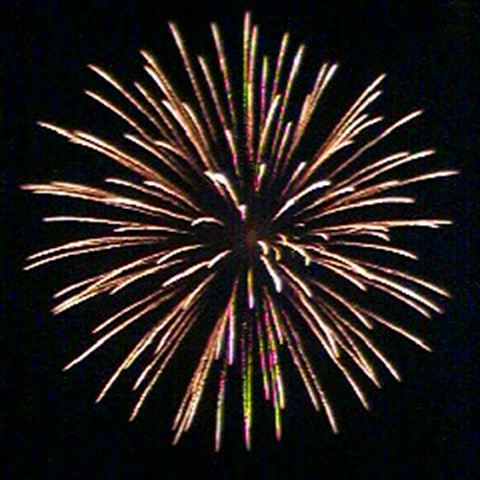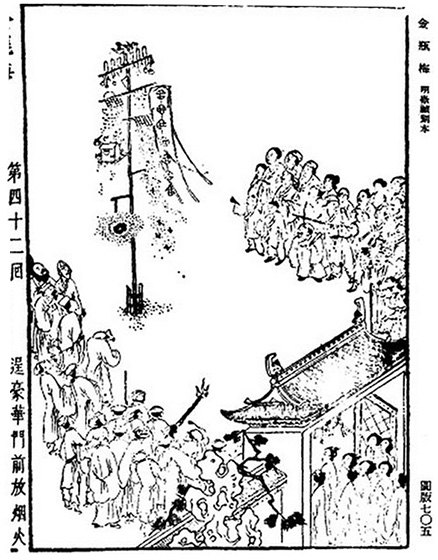
This 4th of July, try regaling your fellow revelers with some firework history and, yes, geology.
They’ll probably know that fireworks originated in China. But they likely won’t know they started as simple bamboo sticks thrown into a fire.
The air inside the hollow stalks expanded, then exploded, making a “crack” that the ancient Chinese used to ward off evil spirits.
A few centuries later, legend has it that a kitchen recipe gone awry combined charcoal, saltpeter, and sulfur. Who knows what food they were trying to make…but they created gunpowder.
Warlords quickly recognized its military potential. Luckily, firecracker enthusiasts pursued its celebration potential.
They filled those same bamboo tubes with gunpowder, to make a far bigger noise, then used more gunpowder to launch ever-larger firecrackers into the air. And fireworks were born.
When Marco Polo came to China, he was so impressed that he took fireworks back to Italy, where they’ve been a hit for over 700 years.
The Italians were the first to add common minerals like gypsum and calcite to produce colored explosions.
The science has come a long way since, now blending in a variety of metal salts and exotic minerals to make better fuels and to add deeper colors and special effects.
So when you see a brilliant finale of red, white, and blue, you can shout, “Wow! Celestine, barium oxide, and copper ore!”
Then you can blame EarthDate for making you the science nerd at the party.
Background
Synopsis: The raw materials for fireworks come from minerals originally combined centuries ago in ancient China and used for warfare. Since then, technology has advanced dramatically to create modern fireworks displays—fantastic multicolored extravaganzas that delight viewers worldwide during celebrations ranging from New Year’s Eve to the 4th of July.
- Firecrackers got their start in China and soon made their way around the world. Today, more fireworks are produced and exported from China than from any country in the world.
- Most historians believe that around the second century B.C., the first “firecrackers” were bamboo stalks that exploded when thrown into fire as hollow air pockets in the bamboo overheated. The ancient Chinese used these exploding bamboo stalks to ward off evil spirits.
- Around A.D. 800, a Chinese alchemist made the first rudimentary gunpowder by mixing saltpeter (potassium nitrate) with charcoal and sulfur (some stories actually attribute the discovery to a failed kitchen recipe). Pouring the mixture into bamboo or paper tubes and throwing into a fire or igniting with paper fuses created the first firecrackers.

- Within a couple of hundred years, the Chinese figured out that they could make bombs and rockets to aim at their enemies. They also used various minerals to create colored smoke and fire to send long-distance military signals, adding to their battlefield advantage.
- Gunpowder weaponry made its way to Europe during the crusades, where the technology was further modified to include destructive musket and cannon balls.
- Marco Polo brought decorative fireworks from Asia to Europe in 1295. Italians were the first Europeans to manufacture fireworks and to add various minerals to fireworks to change their typical orange color to red, yellow, green, and blue. Royalty adopted fireworks displays to entertain their subjects during celebrations and festivals.
- Europeans took their love of fireworks—and their fireworks recipes—to the New World. In 1608, Captain John Smith reportedly set off the first North American fireworks display in Jamestown, Virginia.
- July 4, 1777, the anniversary of the day that the U.S. Declaration of Independence was first read publicly in Philadelphia the year before, was marked in that city by adjourning Congress, ringing bells, setting bonfires, and shooting off fireworks—the start of a tradition that has continued for nearly 250 years!
- Fireworks require a container, fuel, an oxidizing agent, a binder, mineral compounds for color, and a fuse for ignition.
- Modern fireworks are built in tubular aerial shells called “mortars,” which hold dozens of small pods called “stars” as well as the gunpowder that propels the shell up into the air. Each pod contains fuel, an oxidizer, a binder, and chemical compounds for color, sound, and other effects.
- Each 1–1.5 inch (3–4 cm) diameter star has its own fuse and makes a single burst in a fireworks explosion.
- Multiple stars are strung together by their fuses to produce the overall effect desired by the designer of the firework shell once the mortar is high in the air.
- Once the fuel and oxidizing agents within a star are ignited, they generate intense heat very quickly, which activates the star’s mineral-based colorants. Atoms in the colorants absorb energy when heated, causing their electrons to rearrange into a higher energy state than usual. As the electrons drop back to their lower energy state, energy is emitted as light.
- Each element in the colorant releases a different amount of energy, which determines the wavelength—and color—of the light emitted.
- A variety of minerals from around the world go into fireworks production. Most are metal salts, including chlorides, sulfates, nitrates, chlorates, and perchlorates. Some serve as fuel, some as oxidizers, and some are additives that provide color and special effects.
- For ignition, the gunpowder in fireworks requires, along with charcoal, the oxidizer potassium nitrate, mined in the U.S. as saltpeter or niter; and sulfur, a byproduct of petroleum production, which gives fireworks their distinctive smell.
- Bauxite from Canada, Mexico, and Jamaica is a source of aluminum oxide powder that fuels the flashes and bangs.
- Iron filings, which add the sparkles, are mined as iron ores or produced through recycling.
- Zinc derived from global zinc ores may be added to produce smoky effects.
- Minerals provide color to fireworks explosions.
- Nitratine is sodium nitrate, a strong oxidizer that comes from Chile’s Atacama Desert. It provides oxygen to help fuel explosions and sodium that creates a bright yellow color.
- Celestine, from Mexico, is strontium sulfate, an oxidizer that burns deep red. Lithium salts from South America produce a lighter-red color.
- Barite is barium sulfate, which produces a green color; it is mined principally in China.
- Copper ore from the western U.S. is the source of copper chloride, which causes a range of bright blues in fireworks, from turquoise to deep blue.
- Gypsum (calcium sulfate) and calcite (calcium carbonate) create orange explosions. Mixtures of red strontium and yellow sodium also burn orange.
- Canadian pollucite (cesium nitrate) provides a deep blue–purple burst of color, while lavender and other purple fireworks are a mixture of strontium (red) and copper (blue) minerals.
- Bright white in fireworks comes from barium oxides, and from aluminum and beryllium compounds; silver-whites are sourced from minerals rich in titanium, zirconium, and magnesium.

